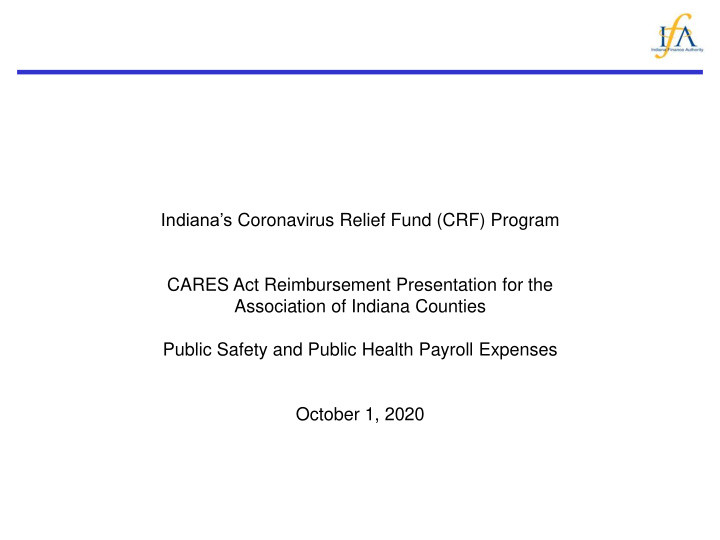



Indiana’s Coronavirus Relief Fund (CRF) Program CARES Act Reimbursement Presentation for the Association of Indiana Counties Public Safety and Public Health Payroll Expenses October 1, 2020
CRF Overview In May the Governor announced that $300 Million of the Coronavirus Relief Funds (CRF Fund) received from the U.S. Department of Treasury via the Coronavirus Aid, Relief, and Economic Security Act (CARES Act) would be made available to reimburse Indiana local units of governments for incurred eligible expenditures. Local units of government include: Counties Cities Towns The State’s Office of Management and Budget has allocated each local unit of government a portion of the CRF Funds based upon population. Each community may access their funds to reimburse eligible CARES Act expenses. You can review your community’s allocation on the IFA’s website here. 1
What may qualify as an eligible expense for reimbursement? As stated in the US Treasury CRF Guidance, the CRF Fund may only be used to cover costs that – Are necessary expenditures incurred due to the public health emergency with respect to the Coronavirus Disease 2019 (COVID-19) Were not accounted for in the budget most recently approved as of March 27 th , 2020 (the enactment of the CARES Act) for local unit of government Were incurred during the period that begins on March 1, 2020, and ends on December 30, 2020 2
Guidance from US Treasury on Public Safety and Public Health employee costs US Treasury Guidance dated September 2 nd provided (in FAQ A.2) – The Fund is designed to provide ready funding to address unforeseen financial needs and risks created by the COVID-19 public health emergency. For this reason, and as a matter of administrative convenience in light of the emergency nature of this program, a State, territorial, local, or Tribal government may presume that payroll costs for public health and public safety employees are payments for services substantially dedicated to mitigating or responding to the COVID-19 public health emergency , unless the chief executive (or equivalent) of the relevant government determines that specific circumstances indicate otherwise. This means that all payroll costs of such employees may be covered using payments from the Fund for services provided during the period that begins on March 1, 2020 and ends on December 30, 2020. 3
What public safety and public health employee payroll costs be covered? Public safety employees Police officers; Sheriffs and deputy sheriffs; Firefighters; Emergency medical responders; Detention officers; and Those who directly support such employees such as dispatchers and supervisory personnel Public health employees Employees involved in providing medical and other health services to patients and supervisory personnel; and Employees of public health departments directly engaged in matters related to public health and related supervisory personnel 4
Prioritize public safety and public health employee costs Based on this updated guidance, the IFA highly recommends that you analyze your public safety and public health payroll costs to determine if you can maximize these costs for reimbursement and in order to limit the aggregate number of requests you may have to submit on behalf of your community in order to utilize all of your available funds. Requesting reimbursement for all eligible public safety and public health costs from March 1st to September 30th would likely enable you to draw most, if not the rest of your available allocation. The IFA recommends for Local governments to first focus on the positions stated previously. For positions not explicitly stated for public safety and public health per US Treasury Guidance, we would need a description for each position which clearly demonstrates how these positions directly support listed positions above in mitigating / responding to the COVID-19 public health emergency. 5
Advantages to prioritizing public safety and public health employee costs Administrative ease 1. As stated previously, by maximizing these costs for reimbursement you can likely limit the aggregate number of requests you may have to submit on behalf of your community in order to utilize all of your available funds More flexibility for use funds 2. Once funds are deposited in your local account any transfer / uses of those funds would be at your elected official discretion and in accordance with State Board of Accounts rules for CARES Act funds. This can include transferring reimbursements for payroll expenses into the Local governments General Fund 6
Directions for submitting reimbursement for public safety and public health payroll expenses The first reimbursement request should be for payroll costs incurred beginning March 1, 2020 through September 30, 2020. Additional reimbursement requests may be submitted monthly if allocated funds are available. Supporting documentation should contain payroll, time, and / or human resource records to support the submitted costs incurred for payroll expenses. Records should clearly demonstrate that the public safety and public health positions submitted for reimbursement are limited to the positions listed on Slide 5. Please note that the IFA will make reimbursement requests for public safety and public health payroll expenses a priority for review over all other designated expense categories submitted. 7
Questions? 8
Recommend
More recommend